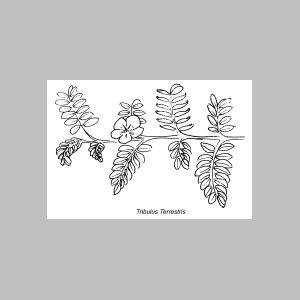Bulletin 3 - October 1977: A Local Wild Flower
A Local Wild Flower
by Pat HarrisTribulus terrestris
Family: Zygophyllaceae
European common names: Maltese Cross, Small Caltrops
Arabic name: Zahra
This hardy plant is a common feature of the sweet sand desert for example around Al Ain and in the Liwa. It grows close to the ground throwing down deep roots. Its bright yellow auxiliary flowers have five petals and the silky pinnate leaves comprise 5 - 8 neatly paired leaflets. For all its fresh and fragile beauty, this is a tough plant that has a reputation for endurance in the desert.
Wilfred Thesiger (1) writes that Tribulus, which is known to the Bedouin as 'Zahra' meaning 'flower', is regarded by the Bedouin as the best camel food and is therefore never used as firewood if any other fuel is available. This is easily explained. Tribulus has none of the unfortunate side effects of the saltbush, for example. (The saltbush, Harrm, has a strong purgative action and also makes the camels that eat it very thirsty.)
In common with other desert plants Tribulus has remarkable powers of regeneration. Thesiger's travelling companion, Al Auf, explained that its long roots reach down into the sand enabling the plant to withstand many years of drought. Plants which looked quite dead on the surface would be green and blossoming one month after a fall of rain. Similarly seeds from the Tribulus plant could stay many years in the dry sand before a welcome shower caused it to germinate.
Al Auf's observations are supported by Professor J. Cloudsley-Thompson (2) who records that "species of Tribulus have been found near Khartoum bearing flowers and fruits less than 25 days of a heavy shower." I, too, have seen tiny Tribulus plants scarcely four inches long with a lovely flowerhead already fully opened.
On a recent visit to the Liwa my husband was surprised to see his Bedouin host inhaling the scent of the Zahra and even placing the flowerheads in his nostrils. Some time later he described this to Dame Violet Dickson who immediately suggested that his host might have had some wound or sickness and the sweet scent of the flower was believed to act as a balm. A link between scents and health is noted in H.R.P. Dickson's book 'The Arab of the Desert'.(3)
Tribulus is not just a desert plant. It is also found in Southern Europe and around the Mediterranean. Its European names, Maltese Cross and Small Cultrops, derive from the shape of its fruit. Five long spines and five short tough spines radiate from the fruit and ensure that whichever way it falls some spines stick upwards. (4)
1. Wilfred Thesiger, 'Arabian Sands' (Longmans) -- camel food p. 123; Harrm pp 148, 149; regeneration p 113.
2. J.L. Cloudsley-Thompson RA, Ph.D., D.Sc., 'Desert Life' (Pergamon Press) 1965 - p. 19.
3. H.R.P. Dickson, 'The Arab of the Desert' (Allen and Unwin) 1959 - p. 511.
4. Oleg Polunin, 'The Concise Flowers of Europe' (OUP) 1974 - p. 62.

Notes:
On 26th August 1977 Tribulus was seen in flower on the sand dunes close to 'Archaeological Site No. 1'. This is adjacent to the Al Ain road and approximately 90km from Abu Dhabi. The plants were rather small but the flowers were well formed.
Calotropis procera, a large bushy shrub, was seen in flower on 7th October 1977 deep in 'Horseshoe Canyon'. The area was visited by the Group in March during a geological field trip. Calotropis, known as 'Ashurr' in Arabic, was formerly used in the manufacture of gunpowder. The specimen seen had purple and white flowers with some pods that contained many seeds. The seeds would appear to be distributed by a downy parachute.